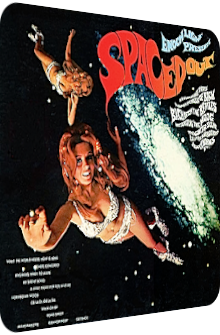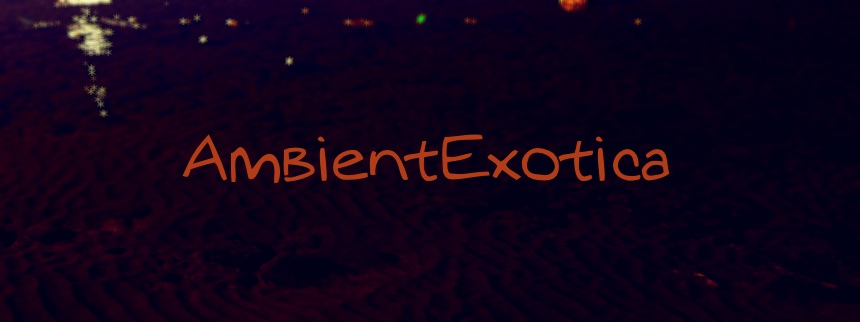
Enoch Light
Spaced Out
1969
The most famous albums by Exotica- or Easy Listening-related artists, conductors or combos are usually the ones where the musicians in charge dare to explore the unknown realms of space and deliver a funky concoction that is so unlike their usual material. To this day, the 101 Strings are generally beloved and deemed important by desultory listeners for just one of their 80+ entries: Astro-Sounds Beyond The Year 2000 (1969), which blends real orchestra strings with the eminently catchy Psychedelic Rock experiments by the ephemeral group The Egg. Likewise, the French-Italian duo of Roger Roger and Nino Nardini may first and foremost be known for their late Exotica masterpiece Jungle Obsession (1971), but the second-most valued entry is their futuristic Moog Pop spacecapade called Informatic 2000 (1982), another late treat for Space-Age afficionados. After the moon race was decided in favor of the United States, even audiophile coryphaeus Enoch Light (1907–1978) could not ignore the heliospheric Space-Age trend any longer, and voilà, decided to gather his Light Brigade in the studio for this 1969 LP Spaced Out, released on his own Project 3 Total Sound label.
A whopping 25+ musicians belong to this eclectic big band, among them skilled organist Dick Hyman, trumpeter Charlie Margulis, guitarist Tony Mottola, accordionist Dominic Cortese and many additional talented fellows, a lot of them known for being band members of percussionist Terry Snyder who, not coincidentally, released his four Exotic Percussion volumes on Enoch Light’s Command label in the late 50’s and early 60’s. Since Enoch Light usually handpicks Jazz standards and Latin material for his many albums, he decides to go a glaringly different route on Spaced Out and interprets – or rather reinvents – various songs by The Beatles, Burt Bacharach and even Johann Sebastian Bach. As weird and vivid as the variety of the material is the soundscape: humming choirs, a stereo-panned elasticity as well as quite a few Moog synthesizers are featured in-between the conventional paradisiac flutes, classic pianos and double bass melodies. Enoch Light’s album is not completely out of space, but remains in more common Jazz climes. Spaced Out nonetheless remains his most vivid and craziest LP.
Burt Bacharach’s Bond Street is the first route Enoch Light and his band are taking in order to reach the Space-Age. A five-note double bass melody and channel-crossing tambourins mesh with quirky Moog droplets, an aah-aahing and doo-dooing mixed choir, Charlie Margulis’ trumpet infusions and Dick Hyman’s organ rivers. The warbled flute transports the Exotica feeling over to the new age, the upbeat rhythm displays the first signs of the upcoming Funk movement. Bond Street proves to be a great start, its melody is catchy and highly hummable and the arrangement seemingly flows freely. Bach’s famous Lover’s Concerto is next. Its place after the energetic Bond Street is highly curious, but hey, this is a Space-Age album! After the prologue, it gets tremendously better anyway: the famous melody is hummed by the choir, golden-shimmering guitar chords provide warmth in the flute-accentuated trombone-focused setting. The obvious highlight, however, is the high-pitched stylophone melody with incredibly blurry orchestra bell synths and a scatting Drum and Bass-evoking (!) shaker. Such audacities were hailed in the Age of Aquarius… and beyond!
Bacharach’s following Knowing When To Leave would have been such a great closing track title-wise, but can gain traction as the third track as well, thanks to its jungular marimba aorta, the Honky Tonk piano, crazily ping-ponging space violins and brass sections which altogether create a gargantuan euphony and make it one of the catchiest, warmest, non-clichéd renditions Enoch Light has ever created. "You should know when to leave, when to fly, when to go" sings the choir in a dreamy fashion, and I concur. To me, it is the best piece of the whole album and – dare I say it? – even surpasses Burt Bacharach’s original vision. A blast!
My Silent Song by Johann Sebastian Bach is very much silkened in Light’s given version. It might cause many people to shiver or contemplate as it is often played during funerals, but this Space Pop take is harmless and vivid enough to not hurt anyone’s feelings. A plinking liquedous acoustic guitar towers above a mélange of humming choirs, Moog-y sine waves and a shoegazing percussion layer. The solemnity of Bach’s sheet music is kept intact and never ridiculed, at least not to my perception. After Bach follows Bacharach, that is the common theme of side A, and so Walk On By comes next, a downbeat Funk critter with buzzing electro specks, Dick Hyman’s bachelor pad organ, surf guitars and mellow horn motifs. If the buzzing synths and the languorous choir were not on board, this tune would have otherwise been a pretty metropolitan and earthen affair due to its city-strolling rhythm and jumpy guitar.
The final piece of side A might divide many a fan, but it is definitely worth your while, I believe: John Lennon’s and Paul McCartney’s Eleanor Rigby is presented in a Latinized manner with many brass eruptions; they oscillate between the polyphony of a good show tune and punchier spy themes. Aqueous piano tones, crystalline synth droplets and spiraling guitars prove to be the spacey ingredients which catapult this big band concoction into higher spheres.
Side B opens with Bach’s A Little Fugue For You And Me. The soundscape provides maximum enchantment: orbiting between a beatnik guitarscape and clichéd Medieval knight tournament fanfares, the remaining minutes are filled with rhythm shifts, electric guitar placentas and stop-and-go melodies which the friendly choir handles very well. It is one of the strangest versions, not at all spacey rather than retrogressive. The following two songs are proper Beatles material: while Norwegian Wood offers gorgeously euphonious flute layers, mellow horns and mellifluous marimbas in a Bert Kaempfert-like big band arrangement with many jazzy influences such as rustic oompa rhythms and double bass-underpinned piano cascades, Ob-La-Di, Ob-La-Da meshes electric guitars and wonky organs in-between the brass flourishes. The whimsical and highly reverb-laden lead Moog synthesizer brings the album back on its Space-Age course, the classic drums, flutes and electric piano notes round off the performance of the uplifting choir. Only the original Reggae-oid flavor of the original is missing. A tremendously catchy track with a good vibe.
Burt Bacharach’s What The World Needs Now Is Love follows and is yet another tune that starts with a Baroque staccato prologue of a brass-driven choir performance, but the theremin-evoking space flute and the iridescent glockenspiel bits in tandem with Hyman’s soothing Hammond B3 organ rescue this overly quirky piece as well. Whereas Johann Sebastian Bach’s last piece on this album, Petite Paulette, takes the Space-Age theme to new heights with shedloads of piercing stylophones, synthetic harpsichords and artificial flutes in Wendy Carlos style, the closing track Get Back revisits The Beatles for the last time, but proves to be a pretty common Jazz arrangement. The only remarkable ingredients are syncopated drums and a rather cool electric guitar which is unfortunately mixed too low-keyed and thus cannot take a stand against the 40’s Crime Jazz feeling. A disappointing closure of an otherwise wildly vivacious journey.
Three B's, twelve tracks: Bach, Bacharach, Beatles. Spaced Out is a successful and highly enjoyable short trip through time (due to its many Baroque and medieval motifs) and space (thanks to its stylophones, Moog synthesizers and electric guitars). Its overall qualities are so good that its aesthetic quality solely depends on the open mind of each listener. Can he or she listen to the beloved but transformed material by The Beatles? Should the eternally hailed work of Johann Sebastian Bach be linked to such an ephemeral Space-Age LP? I cannot give the answer. I, however, want to stress that this is not one of Enoch Light's seemingly soulless, maximum-cash-capturing audiophile releases, but his most innovative work. Sure, the ancient question must arise sooner or later: why is it inventive to take the material of other producers, bands or writers and change it? In this case, it is comparably easy to give an answer: because Light and his band mates not only leave the melodies intact, but change rhythms, arrangements and instruments. These changes prove to be a lot larger in the aural realms of Easy Listening, Space-Age or Exotica than they seem on your screen.
The choir is a huge boon for Spaced Out and much better used than in the beatnik beach parties of James Last and less melodramatic and pompous than in Alfred Newman's and Ken Darby's Ports Of Paradise (1961) or even Tak Shindo's soothing Brass And Bamboo (1959). These guys and girls sound fresh and up for it, and they sure as hell should, as Light moves into Pop realms. And yet is this album curiously focused on jazzy settings as well; it is, in the end, similar to the material the audiophile producer usually comes up with, so this is the small price to pay. The only negative side of the album can be the stereo-panned channel-traveling effects which are decidedly out of date and simply irritating in today's world. Everything else is good and proves the rule of thumb that an artist's Space-Age album offers a refreshing change that sounds all the more vivid than his ususal works. Recommended to every listener who wants to risk a first glimpse onto, into and through the genre.
Exotica Review 170: Enoch Light – Spaced Out (1969). Originally published on Jan. 19, 2013 at AmbientExotica.com.
